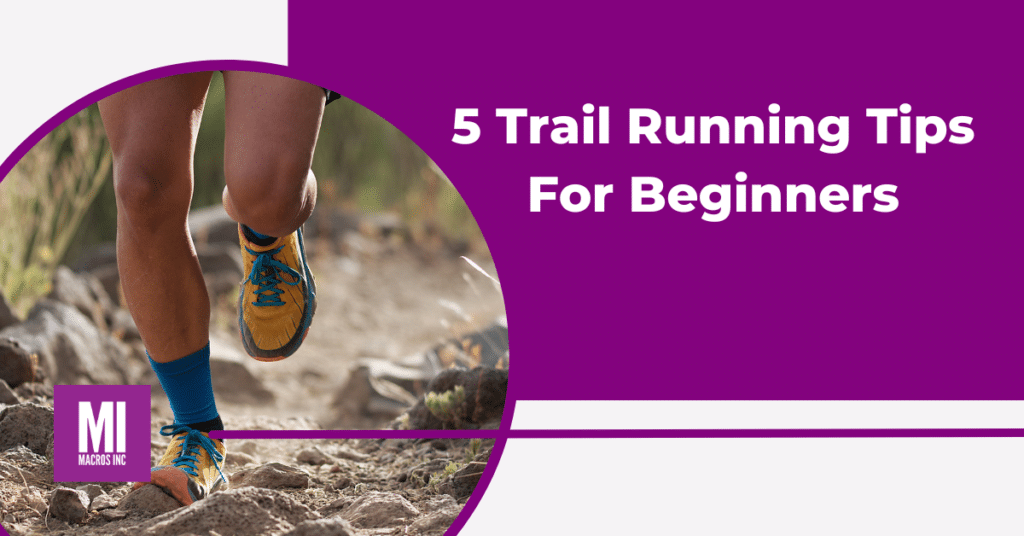It’s time!! Spring trail running time that is! For many runners, this is an exciting time because the trails are open again and there aren’t as many of the different elements to deal with like inches of snow, ice, and the inability to see the path.
For those who may be new to trail running, I can give you a little bit of a breakdown here. Trail running differs from road running due to the varied surfaces you’ll encounter, from gravel to grass. For the sake of this article, we are going to differentiate road running and trail running by the running surface where road running will be considered running on some type of paved surface and trail running on uneven terrain like loose sand, gravel, grass, or soil.
Below, we’ll cover the basics of trail running, including how to adapt from road running, what gear to wear, staying safe on the trails, and following proper trail etiquette. Whether you’re new to trails or a seasoned pro, stick around to learn valuable tips for a successful and enjoyable trail running experience.
Jump to a Topic
1. Adapting to Varying Terrains:
The very first thing to know if you are new to trail running is that your ability on the road may not transfer to the trail. When trail running, you’re running on different surfaces, you may have inclines and declines, and there’s the possibility of needing to avoid obstacles like rocks and roots.
You may have to even shorten your stride and slow your pace to help you avoid some of these different things. Depending on your terrain, you may even want to have running poles for added stability and security for long-distance trail running.
Before setting out, research your trail, plan your route, and check the conditions of the trail, if possible. You can do this through platforms like Strava or AllTrails. This will allow you to understand the elevation changes and other possible technical aspects of the terrain.
Pay attention to the weather of the previous days. Many trails may end up flooded or muddy after even one day of rain.
2. Dressing for Changing Weather:
Although this section intends to discuss dressing differently for the changing weather, I just want to start with your shoes.
There is a huge difference between running shoes and trail shoes. Running shoes tend to have a wider and more comfortable toe box (the front of the shoe) whereas trail running shoes are a little bit more fitted, have increased grip, possible waterproofing or drainage, and have a stiffer sole. The reason for this is to help with better control on the different terrains that may be more technical and uneven.
As for clothing, layers are your friend! Springtime running can be very unpredictable. In some areas, you may get caught in the rain, be exposed to a lot of wind, or maybe a temperature drop or increase. The best recommendation when thinking about layers is to dress for 10 to 15° warmer than you’re expected to experience.
When you start running, you are going to start heating up and this will help consider that. In choosing the different items that you are going to layer, pay attention to the fabric. You will want to be sure to grab breathable, moisture-wicking fabrics. And truthfully, if you’re caught in the rain, this type of material will help you avoid more chafing than other materials may.
Also, it can be very beneficial when trail running to always have some sort of vest or pack to be able to store a light windproof jacket. Some of the running jackets are thin enough and small enough in size that they can be folded up into very small pouches. you could also invest in an emergency poncho to store in your pack as well.
And while you’re at it, include a waterproof pouch for your phone, keys & wallet. I do realize that I am including a handful of different things here but when out on the trail, some of these things may become invaluable and help you get back to your vehicle with everything intact and spared from the elements.
3. Nutrition and Hydration:
As you adjust from winter running to spring running, hydration becomes a much bigger deal. You may begin to sweat a lot more and will need more water & possibly electrolytes. It is always safer to bring water with you on any trail run for safety reasons. A lot of trails tend to not have water stops like other public running routes may provide. As mentioned above, running with a vest or a hydration pack might be ideal.
Before your run, it’s probably best to ensure that you have had something to eat because of having additional variables with trail running like the possibility of getting lost on the trail or having an extended time on the trail as you find your way back to the car. It’s not a bad idea to also carry some additional fueling on top of what you will need in your pack or vest as well.
Finally, maybe think about having a sports drink or more water and electrolytes waiting for you in your vehicle when you finish your run. This can help mitigate some of the uncertainty with the weather and how much hydration you will need without adding more weight to your vest or pack.
4. Safety Tips for Trail Running:
When it comes to trail running, always make someone aware of where you will be, the route you intend to run, and an estimated time frame to expect you to be there. Due to the technical nature of trails, anything can happen. You could be out running and twist your ankle and be sitting waiting for help for a very long time.
Some of the different running watches and correlating apps offer safety systems that can alert someone if you are in an emergency. These items can be life-saving because they will send your location as well as your SOS. It might be good to also have your cell phone emergency contacts set up for easy access if you are with someone else and go unconscious or if found unconscious.
Also, if you have any conditions that would be necessary for paramedics to know, you should keep either a medical ID bracelet or some other information in your pack at all times.
As mentioned above, a vest or pack may be one of the best options for trail running not only for hydration or the elements but for general safety and preparedness as well.
Trail Running Item List (including the optional items listed throughout)
- Trail running shoes
- Breathable, moisture-wicking clothing
- Vest or hydration pack
- Waterproof pouch for phone, keys & ID/wallet
- Medical ID (ROAD iD)
- Electrolytes
- Fuel (gel, chews, food)
- Windproof jacket
- Emergency poncho
- First aid kit
- Navigational tools
- Sun protection (lotion, hat)
- Insulation (emergency blanket)
- A flashlight
- Fire (matches, lighter)
- Repair kit and tools
- Emergency shelter
- Running poles
Finally, trail running does require a bit more attention and focus than road running might. They each have their caveats but you may have to also pay attention to possible wildlife like snakes and all of the obstacles mentioned above like rocks, roots, and mud. Due to this, you may want to forgo your headphones or earbuds.
5. Trail Etiquette:
It is up to us to protect our trails. We want to preserve these trails and the wildlife as much as we can by avoiding disposing of any waste, and widening any trails or trail braiding (branching off the main trail and creating extra trails). When it comes to waste, one of the best things to simply remember would be “pack it in, pack it out”.
Whatever you bring in, make sure you bring it back out. If you bring something with a ziplock bag, you can then use that ziplock bag as your trash bag to carry back out with you.
Otherwise, some quick thoughts regarding trail etiquette. Try to travel quietly. While out on the trail, you may want to pay closer attention to your surroundings and the wildlife and not bring along portable music speakers. This would also be a courtesy for other runners.
Also when it comes to other runners on the trail, be friendly, pass on the left with an “on your left” to not scare anybody, and yield to uphill traffic.
One last thing to be mindful of when it comes to trails is whether or not the trail has cyclists or equestrians. It’s probably best for a runner to yield to a cyclist or equestrian mainly because it is a lot easier for a runner to step off to the side. And horses may get scared easily so it is best to simply stop and let them pass or walk instead.
Conclusion:
Whew! That was quite a bit, but I do hope that this has encouraged and helped you with your preparedness to venture out onto the trails this spring. Trail running isn’t just about exercise; it’s a chance to connect with nature and explore.
By following these tips, you can have a great time on the trails while being mindful of the environment and fellow runners. Not to mention, we’ve covered important things like dealing with different terrains, dressing right for changing weather, staying hydrated, staying safe, and respecting others on the trail. So, as you head out for your spring runs, enjoy the adventure and appreciate the beauty of nature around you. Happy trails!
References:
- 5 Spring Trail Running Tips
- 8 Tips to Ensure You Have a Great Spring Trail Running Season
- Differences between trail running and road running | Salomon
- Training and Racing Etiquette Tips for the Trails — ATRA
- Trail running etiquette: 5 simple rules to live by | Advnture
Try our nutrition coaching, for free!
Be the next success story. Over 30,000 have trusted Macros Inc to transform their health.
Simply fill out the form below to start your 14-day risk-free journey. Let's achieve your goals together!


